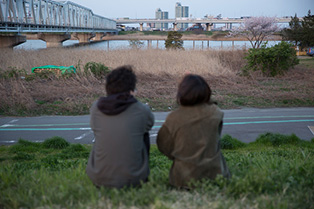
Koki Tanaka
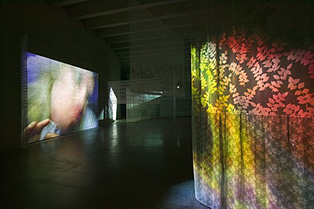
Pipilotti Rist
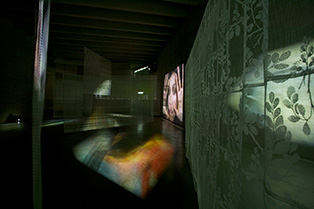
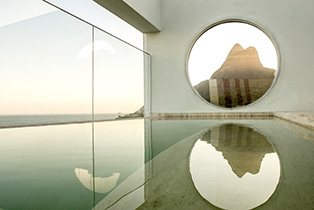
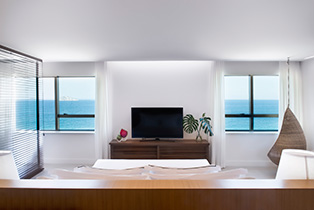
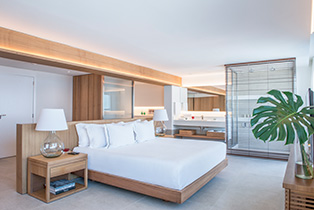

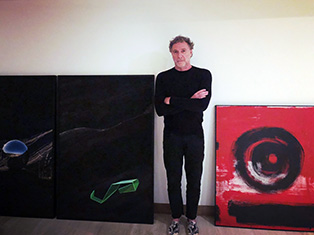
«Koki Tanaka – Vulnerable Historia (Roadmovie)/Pipilotti Rist Video-Installation»
Angesichts der weltweiten Zunahme von Nationalismus, Populismus, Rassismus und Xenophobie konzentrieren sich die künstlerischen Sozialstudien Koki Tanakas (*1975 in Tochigi, Japan) auf das Zusammenleben in Gemeinschaften.
Sein eigens für die Ausstellung im Migros Museum für Gegenwartskunst realisiertes Projekt, «Vulnerable Histories (A Road Movie, 2018», nimmt das durch Unverständnis und Misstrauen geprägte Zusammenleben von Zainichi-Koreanern und Japanern in seinem Heimatland als Anlass, um für ein waches Auge gegenüber Rassismus und Diskriminierung zu plädieren. Sein Projekt wird dabei von einer Reihe von Gesprächssituationen zwischen zwei Protagonisten getragen, die sich zuvor nicht kannten. Begleitet vom Künstler und seinem Kamerateam setzen sie sich in Tokio mit Fragen nach (der eigenen kulturellen) Identität auseinander sowie mit Möglichkeiten, sich den gezielt vereinfachenden Weltbildern rassistischer Gruppierungen entgegenzustellen. Die aus dem Projekt hervorgegangenen Filme zeigen auf, dass namentlich das Gespräch ein wertschätzendes Zusammenleben – im Privaten wie im Öffentlichen – begünstigt und fördert. Die Ausstellung soll den Rahmen liefern, um den von Tanaka initiierten Austausch vor Ort fortzusetzen. So stehen während der gesamten Ausstellungslaufzeit «Live-Speaker» als Ansprechpartner zur Verfügung. In unterschiedlichen Formaten werden mit diversen Akteuren aus Kunst und Lehre weiterführende Diskussionsräume eröffnet.
25. August–11. November 2018
Die Ausstellung wird von Heike Munder, Leiterin Migros Museum für Gegenwartskunst, kuratiert und ist die erste Einzelausstellung des Künstlers in der Schweiz. Zur Ausstellung erscheint im zweiten Halbjahr 2018 eine Publikation bei JRP|Ringier.
Koki Tanaka lebt und arbeitet in Kyoto, Japan. Seine Arbeiten sind international präsent, zuletzt u.a. im Kunsthaus Graz (2017), in der Deutsche Bank KunstHalle, Berlin (2015), im Van Abbemuseum, Eindhoven (2014), im National Museum of Modern Art, Kyoto und Tokyo (2013), im Museum of Art, Seoul (2013), im Hammer Museum, Los Angeles (2012), im Taipei Contemporary Art Center (2012), im Centre A, Vancouver (2010), im Hara Museum of Contemporary Art (2009) und im Palais de Tokyo, Paris (2007). 2013 war Tanaka offizieller Vertreter Japans an der 55. Biennale Venedig, 2015 wählte ihn die Deutsche Bank zum Künstler des Jahres, und 2017 nahm er an den Skulptur Projekten Münster und an der 57. Biennale Venedig teil.
Supported by Arts Council Tokyo (Tokyo Metropolitan Foundation for History and Culture).
«Pipilotti Rist: Perspektivenwechsel»
I.I. Collection on Display präsentiert eine raumgreifende Videoinstallation der Künstlerin Pipilotti Rist aus der Sammlung des Migros Museum für Gegenwartskunst: Show a Leg (Raus aus den Federn) (2001), eine Installation aus Netzvorhängen unterschiedlicher Texturen, über die sich zu einem hypnotischen Soundtrack Videosequenzen und farbige Spotlights bewegen und den Besucher in eine traumartige Szenerie eintauchen lassen.
Die Videoinstallation wurde 2001 auf dem Times Square in New York gezeigt und seither nicht mehr in der Schweiz. Die beschwingt-berückenden farbigen Bilder sind meist aus der Froschperspektive von unten gefilmt, um Perspektivenwechsel geht es der Künstlerin auch im richtigen Leben. So hat sie als Sitzgelegenheiten Kinderstühle in die Ausstellung verpflanzt, damit auch Erwachsene mal die Dinge aus anderer Sichtweise erleben können.
Protagonistinnen von Show a Leg (Raus aus den Federn) sind – wie so oft in Pipilotti Rists Arbeiten – starke Frauenfiguren, die sich, ihrer eigenen Verletzlichkeit bewusst, gegen gesellschaftliche, moralische, aber auch selbst auferlegte Beschränkungen auflehnen und ihre errungene Selbstbestimmtheit spielerisch auskosten. Bezaubernd!
Collection on Display wird von Nadia Schneider Willen (Sammlungskonservatorin des Migros Museum für Gegenwartskunst) kuratiert.
Pipilotti Rist, Show a Leg (Raus aus den Federn), 2001, Sammlung Migros Museum für Gegenwartskunst25. August–11. November 2018
«Interview Oskar Metsavaht, Rio de Janeiro»
Julieta Schildknecht
The artist Dr. Oskar Metsavaht is already well known as Osklen founder and stylist; environmentalist and instituto_e founder; patron of the arts and OM.art gallery owner. His newest project: a sustainable boutique Hotel named Janeiro!
I met him during a sunny late afternoon at his residence in Rio de Janeiro.
Our chat starts with him describing one of his paintings made after experiencing Ayahuasca with the Ashaninka tribe at the border of Brazil and Peru.
One of Rio de Janeiro’s biggest heroes has painted since his childhood.
Metsavaht’s mother founded the faculty of philosophy and art history in Caxias do Sul. His father, was born in Rio but emigrated to the south to found Caxias do Sul’s medicine faculty.
The Physician and Surgeon, with a deep intellectual and science background, first came to Rio to study with Ivo Pitanguy but changed fields and headed to Hôpital universitaire Pitié-Salpêtrière then Institut national du Sport for further specialisation.
The flair for sports and surf, started with his father, a surfing aficionado.
A successful technical clothing he created for high altitudes in 1986, for his first Andes expedition, would ignite the start of Osklen, a brazilian fashion label which became Brazil’s first global luxury brand.
The artist loves opposites and is in constant search of the balance of opposites. His dialectic is about the power of the white and the power of black.
Oskar Metsavaht says Rio de Janeiro mirrors what he understands as art and design representing a perfect life style. The conceptual aesthetics comes from his medical background: a scientific evolution which gives him a broad life understanding in all senses including the spiritual one. His analytical view functions either way: sometimes from a sceptical perspective sometimes from a rational perspective sometimes from a metaphysical perspective. Oskar Metsavaht prefers to keep distance of preconceptions and be open to any art manifestation.
The flair for super 8 film and photography were inherited through his father. Two mediums to remain analogous and always connected to his intuition.
«Everything starts with one black line on white paper, then a second line and a circle and so on,» the artist says. «I like expressing my work from a classical perspective. Every painting, or artistic preparation, comes from a spiritual experience».
«I like to say that an interface between the human being and the environment that surround us can be with another person, a mirror, a lamp, the space (ambience) where we are which ends in a connection, it can be anything. My first interface was biological, with the body and its skin. I would like to mention Alcino Leite’s article in my book “interfaces” which describes well how important it is to me to interface my customers to sensorial experience and design made in Brazil».
«Just as a second skin, I say that fashion is a cultural layer over a body, it is an imagetic layer over the body. Its not just a physical layer».
Between lifestyle and design
When asked about the difference between lifestyle and design…
«We use sometimes lifestyle to explain a lifestyle brand and designers brand. There is no comparison between both. I think inspirations to design come from lifestyle»
When asked if what Osklen sells is lifestyle…
He agrees: «Lifestyle. I could also talk about lifestyle using other peoples designs. However when we begin taking new concepts and new ideas, or even new emotional concepts, we are then talking about pure art».
Fashion is for Oskar Metsavaht one of his art expressions. He translates moments through other art expressions such as a painting, music, film or a text.
As a creative artist he started bringing elements of his lifestyle, from things he sees, things he likes and feels, things he watches and listens, things he imagines and dreams of, onto paper incorporating colours, textures, elements of design, to innovatevely create new trends using Osklen as his platform.
Vision of fashion and art
Oskar Metsavaht shares his knowledge giving speeches abroad where he is constantly invited more than in Brazil, like in Arnheim (Holland) where he gave a speech two months ago. Ingrid van Engelshoven, minister for Education, Culture and Science opened the conference. In Paris the speech was to the European Sustainable Development Fair. In Costa Rica for a very interesting Sustainability Summit co-chaird by Livia Firth.
«I am bringing my sustainability vision through fashion and art. We are considered one of the pioneers in this field».
I asked why does he incorporates spirituality into his art.
He explains it defining his different professional life stages as interfaces. The first one when he became a designer after being a practising physician – from a biological layer to a physical layer. His second interface happened when he became a fashion designer after practising design – from a physical layer to an imagery layer. His third interface is his actual moment – from fashion designer into art – from a cultural layer to a spiritual layer. From his humanist point of view to the environmentalist social side.
Oskar Metsavaht cites philosophy of perception from Boneuf to explain that the inside is the same, for the artist, the philosopher and the physician.
«The moment of art is in that spark, it is in the same, it is a magical moment. It is a metaphysical experience and it is biochemical experience. It is an alignment of the human being. We are the most interesting species in this planet and in the universe. It is the same as when we do meditate or practice concentration. What is religion? Religion is a methodology».
We speak about God and we are able to explain him. The artist speaks about Dogmas and the danger of using them for political purposes. A book on the table «Cristo Redentor – Divine Geometry» is the documentation of a project recently exhibited in the Vatican. «I was invited to exhibit this work in the Vatican and the Pope had this book in his hands».
His next artistic project is about Candomblé.
«I love to contemplate the sun, it helps realign my brain and my body.” He explains how the primitives saw the sun as life each morning after facing cold and dark evenings. The sun, a warm perception and the first divine moment of the human being and the first input to learn where life comes from.
Our rational side comes from the sun and creativity from the moon. Our spirituality has been molded through geometry. A hundred years ago, we didn’t have TV and we would go after signs coming from the stars. Since 100 years we no longer observe the sky».
«If I understand Nature I can understand human beings where they come from, I can therefore understand the environment and myself».
«I don’t consider myself a photographer. I think I know how to use the viewfinder of a camera to capture things I possibly cannot paint. I love photography, because one catches emotional experiences to share with others, one can curate the image. I like to picture in slow motion and out of focus. I have a work called viewfinder, a work that reminds a pinhole camera.I think a viewfinder from a camera is a proposal to see as I am seeing. When a photographer invites a viewer to see something through his / her eyes. One can show it with the imaginary or sensorially the way one sees it».
Science – Spirituality of Nature
The interview evolves towards parallels between Science = Spirituality of Nature. We discuss Oskar Metsavahts book «interfaces I» an artistic immersion in Inhotim. We discuss the interface between the human, art and nature. In the book the chapter is named «traces». Underneath that four words aligned: body // line // path // time
We return to the beginning of our interview to discuss his Ayahuasca experience with the ashaninkas. The word as he explains means people from the stars. The tribe is settled in the Amazon, has around 25’000 people spread between Acre and the border of Peru. Oskar Metsavaht supports a project to teach photography to ashaninka children.
«I try to translate through my art work spirituality into reality. Using all these abstract symbols and the archetype of emotions, I believe people can better understand nature and achieve perception».
Helio Oiticica neo-concretismo is mentioned because of his brasilidade and collaboration when exhibited at his new gallery space.
A propos the rationality of geometry, how would you explain your working process together with architects when designing your Hotel Janeiro? Aren’t there very special elements, objects on walls, the line is quite important?
«What I create for Osklen, the city of Rio and my Hotel Janeiro is the way I see Rio. From a universal perspective, using symbols, styles and bringing concepts, geometry, elements of lifestyle to show people how Rio is. This is what I did with the dunes of Leblon and Ipanema, I brought nature back to beach. Now there is vegetation on those dunes. Hotel means to host. The design in Janeiro is a design for the others but design I would like to have for myself».
Oskar Metsavaht is considered one the contemporary brazilian heroes. A successful idealistic. What he creates is international. He created a movement in fashion and design.His achievements helped him get even more centered and focused as when he started as a fashion designer. The visionary likes to mention that dedication as well as quality are a priority. His are the taste and the sophistication. As a human being, what he creates is to be shared with other people. He dedicates himself to the others knowing this as the most noble value of a human being.
«Realising design is making the abstract real to share it with others. This is my aim. I write through design a universal language and this language has the spirit of brasilian soul. When you love yourself and you think you are a significant person, if you are doing something for you and for the others, your project will for sure be successful. If people love as well its aesthetics, the meaning, the concept, the comfort, or just the aura around the Hotel, the Collection, my designed piece, of course it will be a financial success. Design is not egocentric.
Art I would say is different, it is egocentric. Design is not egocentric. Art is not an object it is an artist experience. If an artist decides to produce and keep it all to himself it is great already.
A friend of mine, Michael Roberts, once told me Osklen is like Oscar Niemeyers work. When you see it you never say it is brazilian, Niemeyer is Bauhaus with a brasilian soul. Bossa Nova is Jazz with a brazilian soul. It is a touch. Gisele Bundchen is a Bauhaus with a brazilian soul».
At last a portrait taken next to two of Oskar Metsavaht’s art pieces made in America created after the california dreams.

